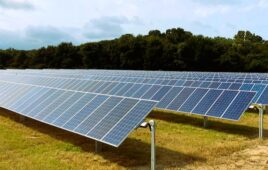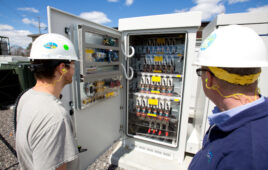New study shows that placing value on avoided power outages can make the economics work for more solar+storage projects
The images and accounts of the devastation of last year’s wildfires, hurricanes and other natural disasters are still haunting. People continue to struggle to regain basic needs, such as food, water and power.
According to the National Centers for Environmental Information (NCEI), 2017 was the most costly year for weather-related losses in U.S. history, with a cumulative cost of more than $300 billion.

The United States experienced a historic year of weather and climate disasters in 2017, including 16 separate billion-dollar disaster events, tying 2011 for the record number of billion-dollar disasters for an entire calendar year. Source: NOAA/NCEI (ncdc.noaa.gov/billions/) (click to enlarge)
In terms of the total number of lost hours of electricity, Hurricane Maria’s impact on Puerto Rico and the U.S. Virgin Islands set a record for the longest blackout in U.S. history, according to economic research firm Rhodium Group. Secretary of Puerto Rico’s Department of Economic Development and Commerce Manuel A. Laboy Rivera estimated economic losses at a minimum of $20 billion. Some economists say that when the drop in productivity is considered, the number could be twice that. Laboy Rivera told the New York Times that the lack of power is the root of the economic losses.
So far, the NCEI reports that the multiple Nor’easters and other storms of 2018 have already exceeded losses of $3 billion. Such extreme weather events have highlighted the need for more resilient energy systems with backup power. While diesel generators are often used, equipment failures and fuel shortages can make them unreliable.
Solar paired with battery storage is an alternative that can provide dependable, cost-efficient backup power. Although system costs have declined in recent years, solar+storage is primarily installed to support ancillary grid services or help with high utility demand charges. However, use for emergency backup power in case of blackouts or natural disasters is arguably just as important, if not more so.
 No clear value for energy resilience
No clear value for energy resilience
Although power outages from extreme weather come with high price tags, these potential costs are rarely taken into account when evaluating the benefits of a solar+storage system.
“It remains the case that building managers and business owners do not typically attribute any monetary value to power outage-related economic losses that clean, resilient power systems could partially or completely avoid,” said Seth Mullendore, vice president and project director for national nonprofit advocacy organization Clean Energy Group, in a blog post. “Because of this, the value placed on installations of solar PV paired with battery storage (solar+storage) systems to avoid power outage losses is zero; that is, the resiliency benefits of these systems have no economic value in project financing considerations and are essentially ignored when making technology investment decisions.”
Data centers or banks may put a dollar value on anticipated losses due to outages, but there is no clear market value for energy resilience. This makes it difficult for organizations―especially those a community depends on during an emergency, like hospitals, first responders and shelters―to place a monetary value on solar+storage investments. So businesses and communities are unlikely to prioritize these investments, and may remain vulnerable to power outages.
“Avoiding outages with resilient solar+storage can deliver significant value to many types of customers,” said Mullendore. “By placing a value on resilience now, more solar+storage could be deployed before the next big storm hits. This is important for businesses, but even more essential to the safety of our most vulnerable populations, like the sick and the elderly, where access to power could literally mean the difference between life and death.”
Having a method for valuing avoided power outages helps solar+storage systems make economic sense.
 Attaching value to avoided power outages
Attaching value to avoided power outages
To study how assigning a monetary value to the benefits of solar+storage would affect project economics, Mullendore co-authored a paper with Joyce McLauren, renewable energy research analyst at NREL. The paper, Valuing the Resilience Provided by Solar and Battery Energy Storage Systems, used data from Southern California Edison to analyze the economics of solar+storage in three applications in Anaheim, California: a primary school, a large office building and a large hotel.
Each scenario considered project economics when placing no value on resilience, and then when valuing resilience in terms of dollars lost per hour of outage. These resilience values are based on customer survey data from a previous study by researchers at the Lawrence Berkeley National Laboratory.
The study assumed a system lifetime of 20 years and measured the lifetime economic benefit in terms of the net present value (NPV) of the system. NPV is the difference between the benefits and costs of the project in today’s dollars. Project benefits include electric bill savings from the solar+storage systems during normal grid-connected operation, as well as the benefit of avoiding a grid outage. Project costs included system installation, O&M and downtime from outage periods or system failure.
To account for variables that affect the number of hours that a given solar+storage system can power critical loads, NREL analysts simulated 8,760 different outages. The modeled outages lasted about two hours. The average system performance of these simulations was used to measure each solar+storage system’s overall ability to supply the building’s critical load during an outage.
 The study found:
The study found:
- It was economical to add solar+storage to the primary school, even without factoring in the cost of outages. But when the value of resilience was factored in, the optimal PV system size increased 20% and the storage system capacity increased more than 13 times. In addition to the benefits of resilience, the larger system would save the school even more on its electric bill, more than doubling the net benefit of the system.
- For the office, solar was cost-effective without valuing resilience but not storage. When accounting for the cost of outages, the ideal PV size increased by 35% and adding a 271-kWh battery storage system made economic sense. The avoided outage losses and increased electric bill savings meant a 160% NPV boost over 20 years.
- Without incorporating the value of resilience, it made little sense for the hotel to add solar or storage. But factoring it in made adding both cost-effective.

“While these results are for hypothetical scenarios, the value of avoided losses and the impacts from outage costs that were modeled represent real-world data from utilities and their customers. The expense of power outage-related losses can be devastating to businesses,” said Mullendore.
Clean Energy Group and NREL’s analysis shows that while solar+storage may not be economical under traditional cost-benefit calculations, placing a value on the losses from grid disruptions can make solar+storage a sound investment.
“The key takeaway from the paper and recent disaster events is that energy resilience and technologies that can help boost resilience have value,” Mullendore said. “Investing in technologies that can avoid outage-related losses can make a lot of economic sense, and not accounting for that benefit could ultimately cost people money, or worse. By valuing resilience now, solar+storage could be installed before the next storm hits, instead of as an afterthought, as in the case of Puerto Rico.”




Tell Us What You Think!